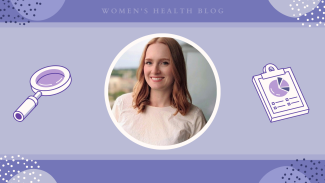Interviewee: Alex Lukey, PhD, University of British Columbia, School of Population and Public Health. Authors/Editors: Negin Nia & Romina Garcia de leon (Blog Co-coordinators).
Published: August 12th, 2022.
Alex Lukey, a previous Women’s Health Research Cluster (WHRC), Blog Co-coordinator is speaking to us about her work on ovarian cancer prevention. Lukey is working on preventing ovarian cancer using big data and machine learning. Read more to find out about her work and how she got into the women’s health field.
Could you please tell us about your current research?
The lab that I work in studies ovarian cancer, specifically the prevention aspect. So, the project that I am going to be working on focuses on using the big datasets that are in BC to try and predict ovarian cancer. This is to possibly make recommendations in a clinical setting regarding prevention efforts.
My supervisor, Dr. Gillian Hanley, works around opportunistic salpingectomy. In the last 10 years or so the research found that a lot of ovarian cancers start on the fallopian tube rather than the actual ovaries. So, about 10 years ago a team in BC started doing opportunistic salpingectomies. This means if someone goes into another gynecological surgery, and they are done having kids (or don’t want any), they can have their fallopian tubes taken out by choice, at the same time.
We now have studies that show that removing the fallopian tubes is effective at preventing the most common and deadly form of ovarian cancer. My PhD will be looking at this and seeing if we can take this a step further by possibly targeting people who are at higher risk. I am also going to be doing qualitative research because it is a big decision to undergo surgery and to make that decision as a patient – but this is why the research is needed.
What sparked your interest to pursue this work?
I have always been interested in women’s health research. My Master’s in nursing at UBC Okanagan focused on improving heart failure self-care through gamified education which so my PhD work is pretty different, but even back in nursing school I volunteered at the Options for Sexual Health Clinic. So, I have always been interested in making women’s health research more equitable because there are so many big gaps.
Before my PhD I was working with Dr. Hanley on a project that was looking at hormone replacement therapy on a grant I was awarded called the CIHR Women’s Health Clinical Mentorship Grant. After that, I decided to keep working with Dr. Hanley as my PhD supervisor because she’s a fantastic researcher and her lab focused on my interests of ovarian cancer and population-based data. I knew I wanted to work in big datasets for my PhD because there are many opportunities to translate research into provincial, national and even international knowledge and answer important research questions.
How do you hope this research will impact the women’s health field?
For me, the most tangible impact would be that we are allowing patients to make that decision regarding preventing ovarian cancer around their own bodies and health. Before we can offer salpingectomy at a greater scale for preventing ovarian cancer though more work needs to be done. This is totally an individual decision, but I want people to be able to take their health into their own hands.
The cancer survival rate has not really moved much in the last 30 years. There have been better treatments and drugs coming out. But the five year survival rate of ovarian cancer is still less than 50 per cent which is pretty abysmal. This also affects a lot of people on the younger side, in their 50 or 60’s. It’s a very deadly and devastating disease and often has major long term health impacts for those who do survive. Survivors can have their quality of life impacted through things like sexual dysfunction, bowel dysfunction, and continuing pain just to name a fewy. So, we are just trying to help prevent ovarian cancer from happening in the first place.
Did any of this tie into the work you did with the WHRC as a Blog Co-coordinator?
I definitely would say that, when I was a blog coordinator it was a really great experience to learn about a lot of different research areas. It was also really cool to see what other people were working on. I learned about so many impressive research projects going on in women's health. And it's really exciting to see so many really motivated researchers out thereIn research, you often have to just pick your little area and kind of stay focused on that. But I think it was really exciting to see how many different areas are being addressed even just in BC and Canada.
Is there anything else you are currently working on?
I am still helping out with the trainee research presentation for the WHRC. We just had one in June and we will likely have another in September. I love hearing about more research being done in the field of women’s health and it is an opportunity for trainees ranging from undergrad to post-doc to showcase their work and practice presenting. So, if anyone wants to participate in that, then they can reach out to me.
Where can people find you and your work?
I’d be happy to connect on Twitter so I can be found at @AlexandraLukey there for any questions. If people are more interested in the research aspect of things feel free to email me alukey@mail.ubc.ca
